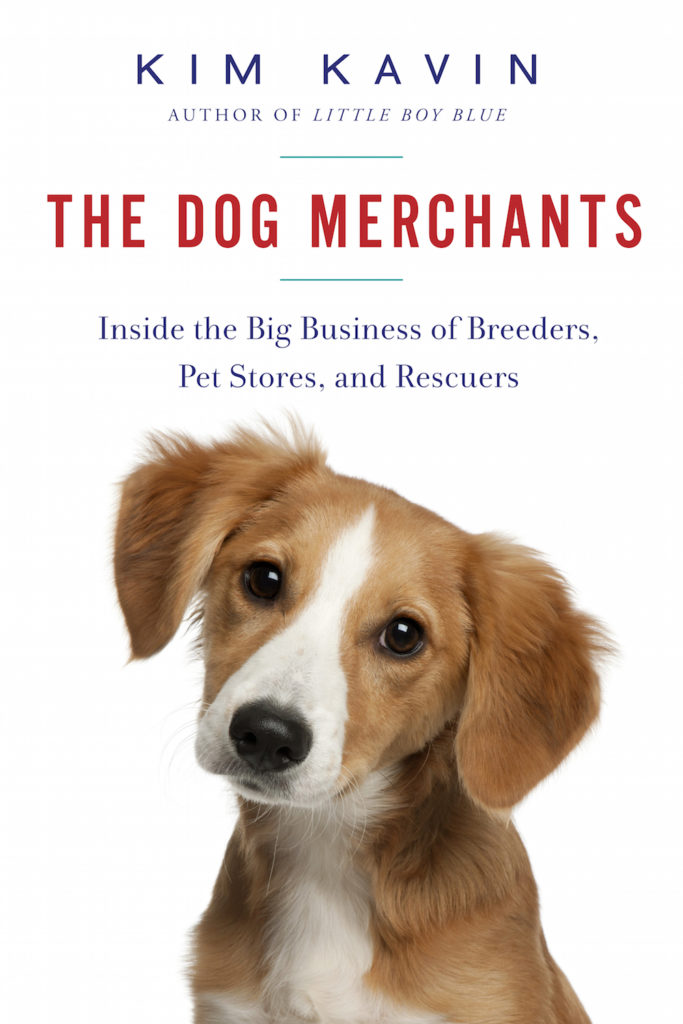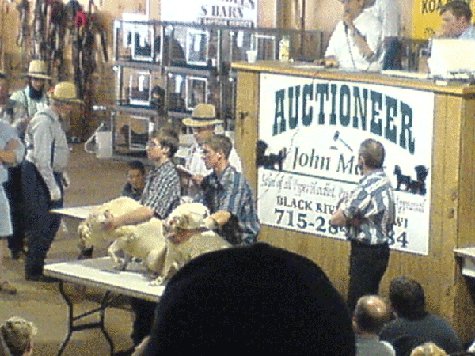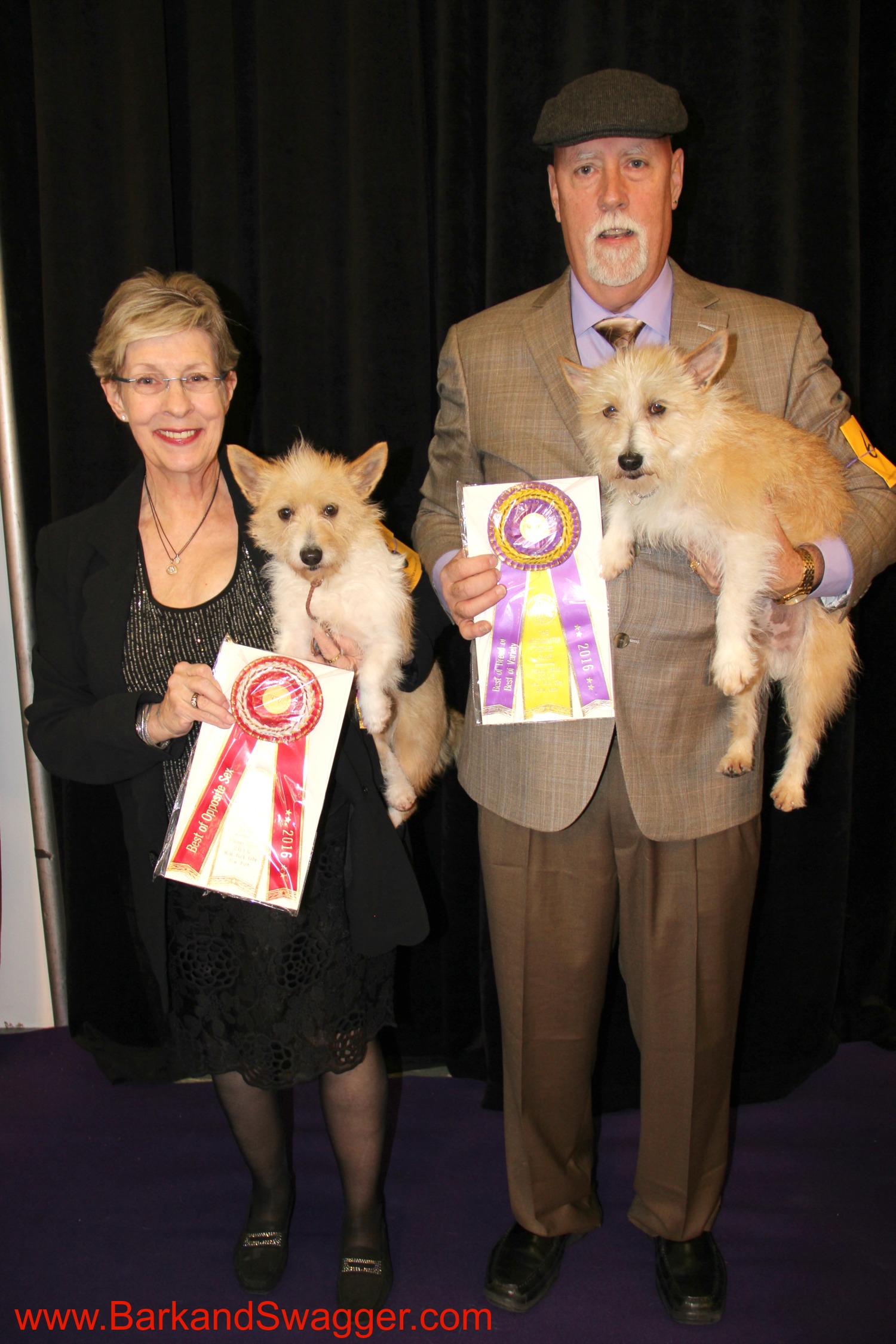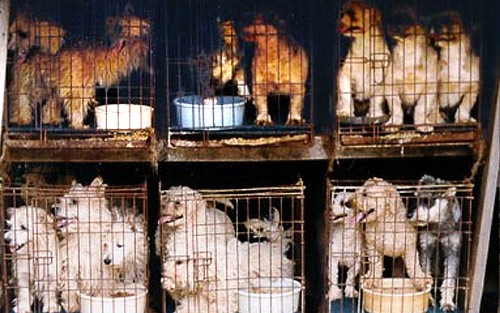What’s the Difference Between Dog Rescue Groups & Breeders; Westminster & Puppy Mills? Less Than You Think.

Did you know many breeders and dog rescue groups get their dogs from the same place? Auctions. That’s right, that fancy breeder could frequent dog auctions, sitting shoulder to shoulder with puppy mill breeders and rescues, all bidding for the hundreds of pups paraded before them. So what’s the difference between breeder and rescue; Westminster and dog auctions? Less than you think. These questions and more are explored in what is, hands down, the most fascinating dog book I’ve read this year. It’s called The Dog Merchants:Inside the Big Business of Breeders, Pet Stores, and Rescuers by Kim Kavin, and it was touted as, “Essential reading for all dog lovers, this balanced work will become the standard on this topic.” Library Journal (starred review)

Author Kim Kavin and her dog, Blue.
Have we been duped, or don’t we know the whole story? Kavin takes an investigative journalist’s approach to shedding light on an industry many didn’t know even existed. And, while she doesn’t judge any facets of that industry, she makes it very clear how an educated consumer can create real change in making the dog business a better place for dogs. We’ll look at how coveted shows like Westminster and Crufts exist to fuel and expand the purebred market. We’ll see why pitting rescue and purebred people against each other does nothing to advance the humane cause for dogs. Kavin will take you through it all: the production, marketing, and sale of dogs as a commodity; small and large-scale breeders, show dog promoters, dog auctioneers, puppy distributors, public shelter workers, private rescue volunteers, animal law experts, dog-savvy marketers and more. If you love dogs like I do, this may sound very distasteful to you. I found it fascinating and am grateful a journalist like Kim Kavin researched and wrote about it, so we, too, can educate ourselves about this business of dogs. After all, knowledge is power, right? And, you’ll see just how powerful you can be.
Sobering statistics you might not know:

Created by Bark & Swagger with statistics courtesy of NoKillAdvocacyCenter.org. August, 2014
- About pet overpopulation: “A reasonable estimate is that some thirty million pet dogs are brought home around the world every year. Dog lovers could give a home to every single dog who has been abandoned in every single shelter, and millions more pups would be needed annually to satisfy consumer demand.
- About the business of selling dogs: “The money spent buying dogs as pets represents income to small- and large-scale breeders, pet stores, public shelters, and private rescue groups of somewhere in the vicinity of $11 billion each year around the globe. Now, those numbers are admittedly fuzzy; all numbers involving the buying and selling of dogs are estimates because no central databases exist (that’s one reason, perhaps, that no book like this has ever been written, because it is so hard to pin down exactly what is going on in terms of cash flow in the dog business). Still, given the statistics available, it’s reasonable to assume that the business of selling dogs has about the same value as the global IKEA brand.”
Dogs are, in fact, big business and, as you’ll see, everyone’s in on the action.
The Money: What’s At Stake?

Wheaton, Missouri is the heart of one of the biggest dog breeding regions in the U.S. And Bob Hughes, of family-owned Southwest Auction Service, is the B.M.O.C. (Big Man On Campus). As the largest legal dog auction house in the country, Hughes has moved hundreds of thousands of dogs out to breeders and rescues since his parents started the company in the early 60’s. “They were among the first people to tap into what would ultimately become the biggest market for purebred dogs in the history of the world,” Kavin reports. It began with Bob’s mother, Sue, wanting a color tv. To earn the extra money, she bought two Poodles and started breeding, shipping them out to her mother in Columbus, Ohio, where they could be sold from newspaper ads to the big city market. As Hughes explained in the book, “‘It got to a point where my grandmother told Mom, ‘I can’t keep up with selling all of these puppies, but there’s a pet store here in Columbus that wants them.’ Well, that was the first-ever Petland. They’re now the biggest chain of pet stores in the USA.'” The Dog Merchants
What kinds of dogs enter the auction bidding ring and what’s at stake in terms of profits to be had from them? Every breed you can imagine is there. Some come from what’s known as breed sellouts, where the owner is no longer breeding that type of dog and has no use for them, as in the case of American Eskimo, Alice, called Dog #1 in the book. “The sale of dog number 1 was a pure business transaction, one based on her status as breeding stock,” Kim observed. Many are AKC-registered, coming from higher-end breeders. Some come from small commercial breeders. Many are already pregnant.

Kavin’s example of the money trail is very enlightening, utilizing as an example a West Highland White Terrier, purchased for $650.00 at auction. She writes:
“A commercial dog breeder will get two litters of puppies out of that Westie during each of the five years after purchase. Every litter with a Westie is four to eight pups. That means a total of eight to sixteen puppies a year, or forty to eighty dogs coming out of that single Westie in five years’ time. Even if the breeder sells them all as males and non-pregnant females to a broker at a discount, for $100 apiece, that’s $4,000 to $8,000 going into the breeder’s pocket.
“The broker will then sell those dogs to the pet stores at maybe half of their retail price, or about $400 apiece. So, subtracting the original $100 per puppy, that’s another $12,000 to $24,000 in income, creating a total of $16,000 to $32,000 so far from the initial dog. The pet store then sells those purebred Westies to the public for the retail price of, easily, $800 apiece. That adds another $16,000 to $32,000 in gross income, for a conservative total of $32,000 to $64,000 – every cent of it generated by that original $650 female who was sold at the auction five years earlier, and who will probably be brought back to the auction table only after her breeding production slows, when she’s considered used up.” It’s a heartbreaking scenario, and yet, this is the reality of the dog business.

The Business of Buying Dogs: How Different is the Breeder from the Rescue, Really?
When I discovered The Dog Merchants in a New York Post story, it was this that compelled me to reach out to Kim Kavin and talk: “‘What’s happening is a paradigm shift. People still want puppies. The brick-and-mortar pet store, at least in New England, is being replaced with the virtual pet store, which is Petfinder.com,’ [Rhode Island state veterinarian, Dr. Scott] Marshall says. ‘Rescues have created an us-versus-them mentality. They say, Get the dogs from us, not the pet stores, because they work with puppy mills. I think those lines are very blurred, and now with the Internet, the middlemen are being eliminated. Dog breeders are going to end up selling to the rescues because it’s more profitable for them both, and people are going to be getting their puppy mill puppies from the rescues.’ That concept may sound bizarre, but it’s already happening.” We “bought” our two Chihuahuas, Anabelle and Albie, from no-kill shelter, Abandoned Pet Rescue in Fort Lauderdale. In their case, they were pulled by APR from the municipal kill shelter, which had raided the puppy mill, but who’s to say in other cases that those puppy mill dogs weren’t sold at auction to a rescue organization?

Our little Albie
Jane Rosenthal used to be a show breeder of Japanese Chins. After cancer took the passion out of it for her, Rosenthal attended her first auction and saw a woman buying dogs for a rescue group. “She was outbidding the breeders to move the dogs from the commercial life into homes as pets,” Jane told Kim. Before she knew it, she was helping other rescue groups do the same thing, sitting side by side with breeders, puppy mill owners and other rescues, all vying to outbid the other for the dogs they want.
But, while rescuing dogs from a life as assembly line breeders is honorable, not all rescues feel the same way about buying at the auctions. Mary O’Connor-Shaver, with Columbus Top Dogs rescue, has been trying to get the auctions banned from Ohio, and believes people like Rosenthal are only helping the commercial breeders by putting even more money into their pockets via the auctions. I would probably do what Jane is doing were I there, but already, the lines were blurring for me. Like many of you, I would pass a pet store and shake my head in sadness for the parents of the puppies sold there, trying to enlighten people about why Adopt, Don’t Shop is so important. But, I was part of a money transaction to buy Sophie, and to rescue Jasper, Ani and Albie. One was called the price of the dog, the others were called donations. And we now know that some of the dogs from both, were coming from the same place…the auction houses. So, if this is true, what’s the point of pitting breeders against rescues? What you’ll see is, if breeders and rescues came together, what a powerful voice they could be for change.
Westminster & the Show Breeder & The Puppy Mill: How Are They All Connected?

The Westminster Kennel Club Dog Show is the “Rolls-Royce brand” among other venerated dogs shows like Crufts in the United Kingdom and the FCI World Dog Show. I’ve been going to Westminster practically my whole life, beginning as a kid with my parents, eager to watch the beautiful dogs parade across the stage, seduced by the women and men in the front rows in their fancy gowns and tux’s and excited by the visit backstage to get up close and personal with the best of the best of breeds, accessible to show goers. As an adult, I went less frequently, but in the past three years, I’ve attend to cover it for my blog. And like so many people, I’d never thought of Westminster in the way Kavin describes:
“Quite a few of the people cheering, along with many of the seriously invested people down in front, likely would have been disgusted by the scene at the auction house in Missouri. Yet here, under the arena lights with the $20 programs and household-name television personalities, they had no qualms at all about what was happening. The reason is simple: this dog show – which dates from 1877, the same year the railroad and steamship tycoon Cornelius Vanderbilt died – allows breeders to do business in the style of the Old Money class. They have long been savvier than the purebred owners who spend their days breeding dogs on struggling family farms and going to auction houses when they can’t make ends meet. Like the first of today’s so-called reality television celebrities, the people in the tuxedos and gowns figured out decades ago that, instead of banning the cameras, it was better to invite them inside and control them, to turn a breeders’ event into a glimpse at the dogs of high society…In other words, the show being put on display for the public may have been entertaining, but the real show going on tonight was about the business of breeding, even if few of the fans ever noticed.”
When I think about it, after having read the book, it seems very clear. Westminster has a purpose: to promote the creme de la creme of breeders and the business of dog breeding; to help breeders sell dogs. Without the breeders, there’s no Westminster or any of these other competitions. And like with any live television show, the “studio” audience gets to hear a different show than the at home viewers. In the case of Westminster, Kavin, who attended in 2013 while researching this book, points out the earful of manipulative messaging about the superiority of these champion bred dogs, intended to make them “must-have’s,” all covered in a sweet coating of pure entertainment.
In 2013, when the Portuguese Podengo Pequeno was making its first appearance, after being added as an official breed to the AKC, the traditional fawning and fussing was made over these dogs. I was there, thrilled to witness it, because our Sophie is a Podengo . Here’s what Kim observed:
“Then viewers were taken backstage to meet a Portuguese Podengo, which, along with the Rat Terrier and Chinook, was making its debut as a new breed in the show. The camera lingered on the Podengo for a few minutes, much as it might while showing off a concept design from Porsche or Ferrari at an international car show. The Podengo was indeed a nice new option for buyers, soon to become available from dog dealers worldwide.”

Sandy Gillen with Portuguese Podengo Pequeno, Teasel, and John S. Fitzpatrick with Augie
This is the problem. Westminster, Crufts, and others like them are central cogs in a big wheel, dictating what the next “must-have” dogs will be. What happens when Princess Kate wears a dress from a particular designer? Hundreds of thousands flock to buy the knock off at H&M.

Here’s where Kavin makes the connection clear: “Nobody appeared to feel a sense of irony about the fact that the purebred dogs Westminster held up for the world as the most stylish – the ‘must haves’ on television – would soon be churned out in big quantities by those puppy mills they disdained and sold as knockoffs just like the handbags on city corners at the end of Fashion Week…The breeders and fans at Westminster seemed proud to be recognized for doing an entirely different thing, as opposed to doing the same thing differently, from the people back in Missouri.” This is breeding driven by marketing, as opposed to driven by the love of and the bettering of a breed, something the most respected breeders will tell you is a big no no.
Remember Banana Joe?

That adorable Affenpinscher who won Best in Show at Westminster in 2013 was EVERYWHERE. You couldn’t turn on the tv without seeing him in the days following his big win. Then, Affenpinscher madness set in and the breeders went wild. At the time of Joe’s win, Bloomberg Businessweek reported there were only seven Affenpinscher puppies for sale in the entire U.S. and that only 12 AKC-recommended Affenpinscher breeders existed in all of North America. They sold at that time for about $2,500 from an AKC breeder; about $400 from a commercial breeder. Less than a year later, Affenpinscher puppies would be flooding websites like PuppyFind.com without registration papers at an asking price of $1,500, quadruple what it was. Their presence at puppy farms (read “mills”) and small breeding operations also mushroomed, thanks to all of that media attention. This is exactly what happens when the market steers the breeders. And, who suffers? The dogs.
“To me, breeds are like a designer handbag,” writes Vanessa Woods, a research scientist at the Duke Canine Cognition Center and co-author with husband, Dr. Brian Hare, of The Genius of Dogs. “People like the way they look and the hype behind them. They buy into stereotypes (Border Collies are the smartest, Labs are the most faithful, etc.) and then they match up how they see themselves with the marketing behind the dog.”

While that sounds kind of innocuous in and of itself, the breeding behind creating these designer dogs has had grave consequences for the dogs themselves. Look at what’s become of the beloved German Shepherd, a noble, bright breed of dog who can’t grow old without being afflicted with either hip dysplasia or spinal degeneration disease, the horrific condition my beautiful India suffered from, beginning at 9 years old until almost 14, when she died unable to walk or control her bladder. Or, the English Bulldog, bred to have snouts so short they can barely breathe, so much so, that airlines refuse to fly them during certain times of the year, because they’re too big a health risk. And that, because of a vague breed standard like, “the shorter muzzle is preferred.” Interestingly enough, Kim reported from her research that the early science shows, contrary to popular belief, modern dog breeds are almost exclusively about looks and hardly at all about temperament or what makes a dog a good addition to a family. But hey, it’s all about following the money, right?
Come back tomorrow for Part 2 of The Dog Merchants!
What do you think of what you’ve discovered thus far? What surprised you the most?
If you liked this story, you might also like my story on the No Kill Movement, Part 1.








Good article! I like the analogy that the business of dogs is similar to the marketing of designer handbags. Designer handbags are a status symbol, and sadly that drives demand of purebred dogs. People think if they have that purebred dog at their side, it will make them look more important and increase their status and credibility. Some people want to imitate famous actresses and carry around a fancy pocket breed in their purse so they can feel more important. Then there are the tough macho types who think the latest and greatest mastiff guardian breed will make them appear powerful and invincible.
It really is about marketing, and we are all being duped!
Hi Sharon – I guess its human psychology, to an extent, and events like Westminster play right into it, cultivating our tastes for wanting the must have, the next big thing. So sad how the overbreeding, when that happens, affects so many dogs. But what I love is this book shows us how to take our power as consumers and harness it for good for the dogs. I love that she’s created a database where you can review your rescue, breeder, pet store – wherever you got your dog – so others can see if they’re responsible or not. Brilliant. One of those ‘how come no one’s done this before’ type of things. 🙂
The thing that has surprised me most is the history she gives behind things like the Hunte Corp, the auctions, some of the large scale breeders, some of the history of the AKC….while those of us in rescue view these people as the bad guys, some of the work that they do was started by their desire to make things better for the dogs (and their business). Kim’s idea of making this about responsible vs. irresponsible makes sense to me. I think that the dogs stand to benefit by breeders and rescues becoming educated about the whole industry, and finding common ground to help each other help the dogs, instead of throwing daggers back and forth. Thank you for promoting her book. I’ve learned a lot from reading it!
Thank you so much for your comment, Coyote Windsong. I feel exactly the same and also learned so much from reading Kim’s book. I think it’s so important for people to educate themselves after reading it, that I want to tell everyone I know about The Dog Merchants and, pretty much, am doing that. Please share, too, if you would to help get the message out there that an educated consumer can really make a difference for the dogs. Did you review the place you got your dog(s) on her Dog Merchants site? I love that she’s creating one place for people to go when they want to get a dog, so they can gravitate towards the responsible people and shun the irresponsible. If enough people do that, the irresponsible go out of business and what a happy day for those dogs it would be, right? Thanks, again!
Yes, rescues will sometimes buy dogs from auctions, but they do so in order to get those dogs out of the puppy mill cycle and get them into homes. While some breeders just breed dogs over and over until they are no longer of value to them, others will sell them off to other breeders. The dogs obtained by rescues this way are vetted, and find homes for those they can. The sad truth is that many of the dogs being released from puppy millers and backyard breeders have been neglected and overbred to the point where they are difficult to adopt out due to the number of medical issues they have. Some of these dogs go to hospice fosters where they get the first real love of their lives and live for maybe months – maybe more, maybe less. For the most part, dogs from puppy mills are totally un-socialized and it takes a lot of effort to get them to trust humans enough to find them homes. I’m a volunteer rescue transport driver and I’ve seen first-hand some of the dogs coming from these hellholes.
Yes, I’d definitely do the same thing as a rescue trying to save these dogs from a life of breeder servitude. I think the interesting thing here, and you’ll see more in tomorrow’s post, are the ties between the seemingly disparate entities…Westminster and puppy mills, for example. I had no idea you did transport. That’s amazing, Linda! It’s heartening to read about how many people are involved in the chain to help dogs coming from horrible environments get into better environments and then get adopted into forever homes. Bless you!